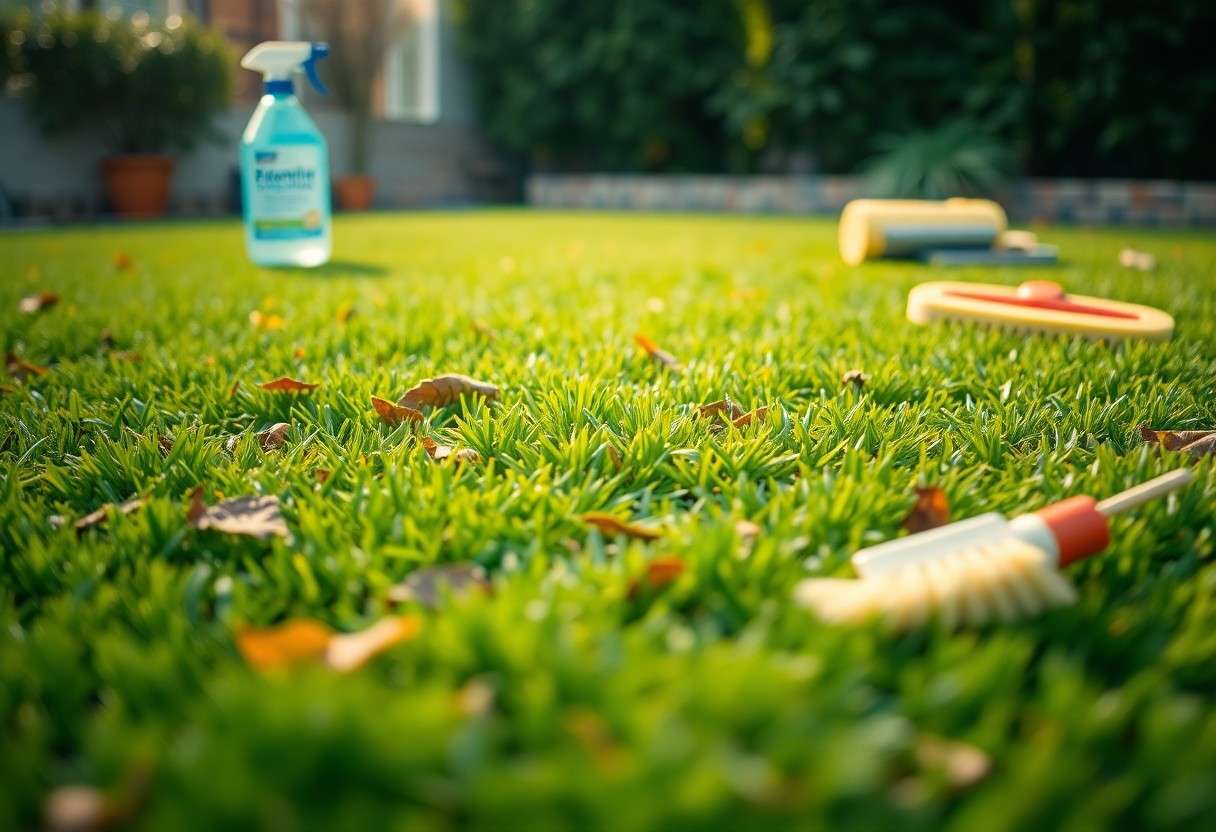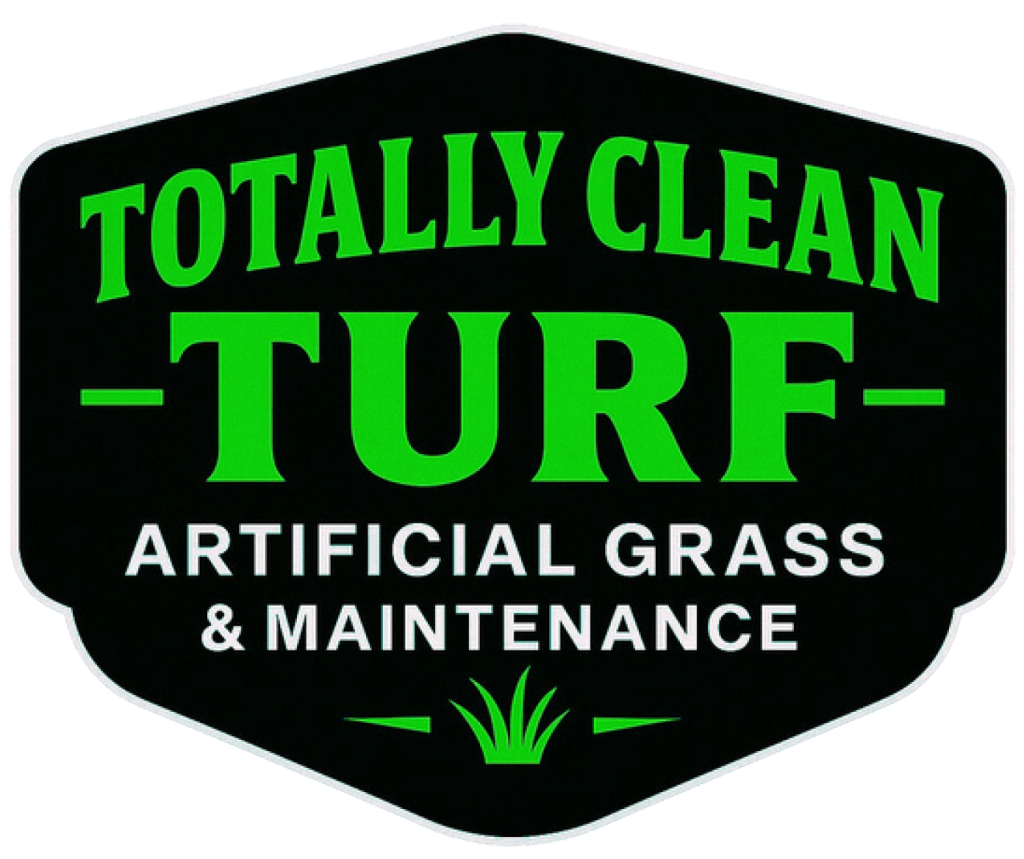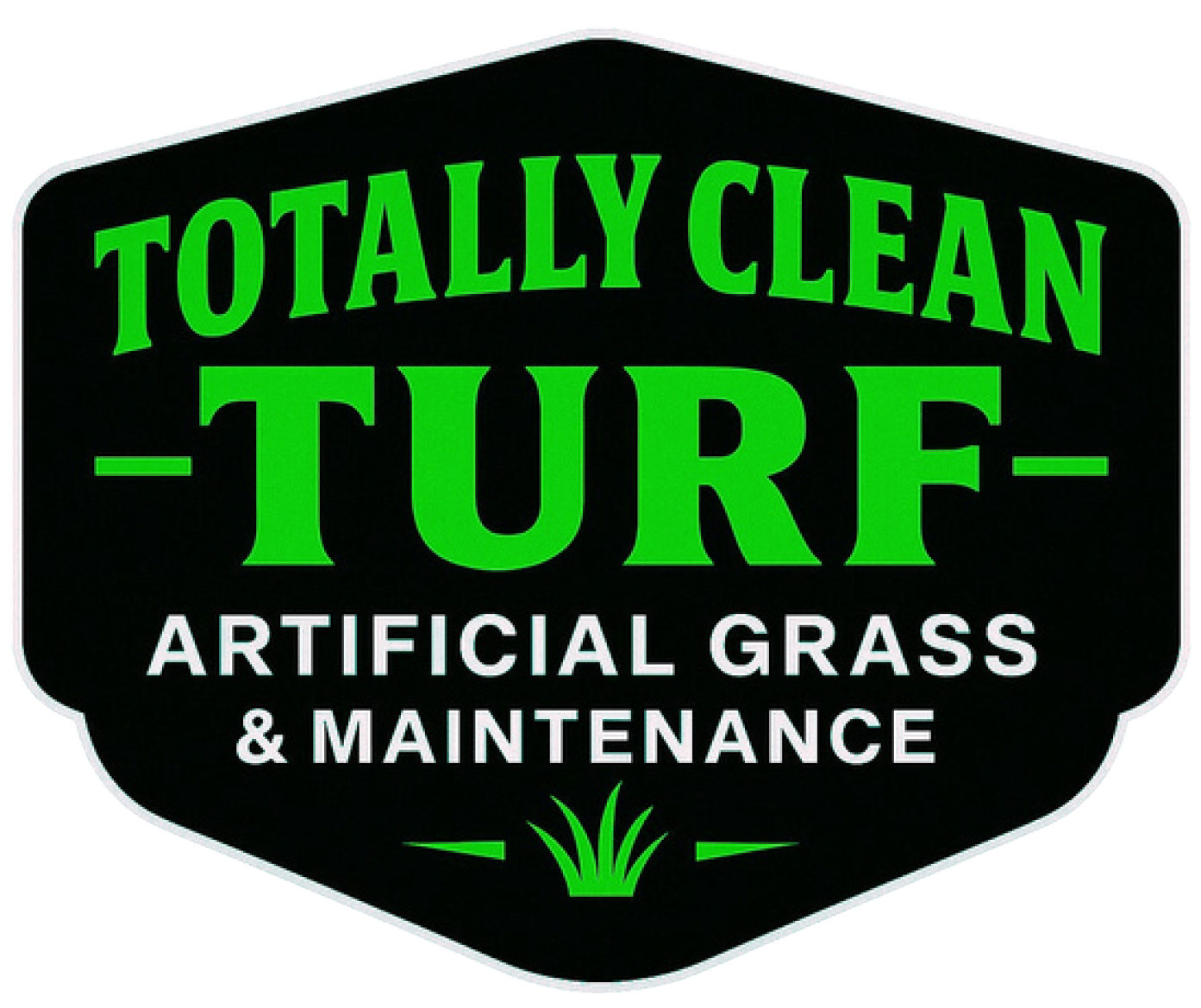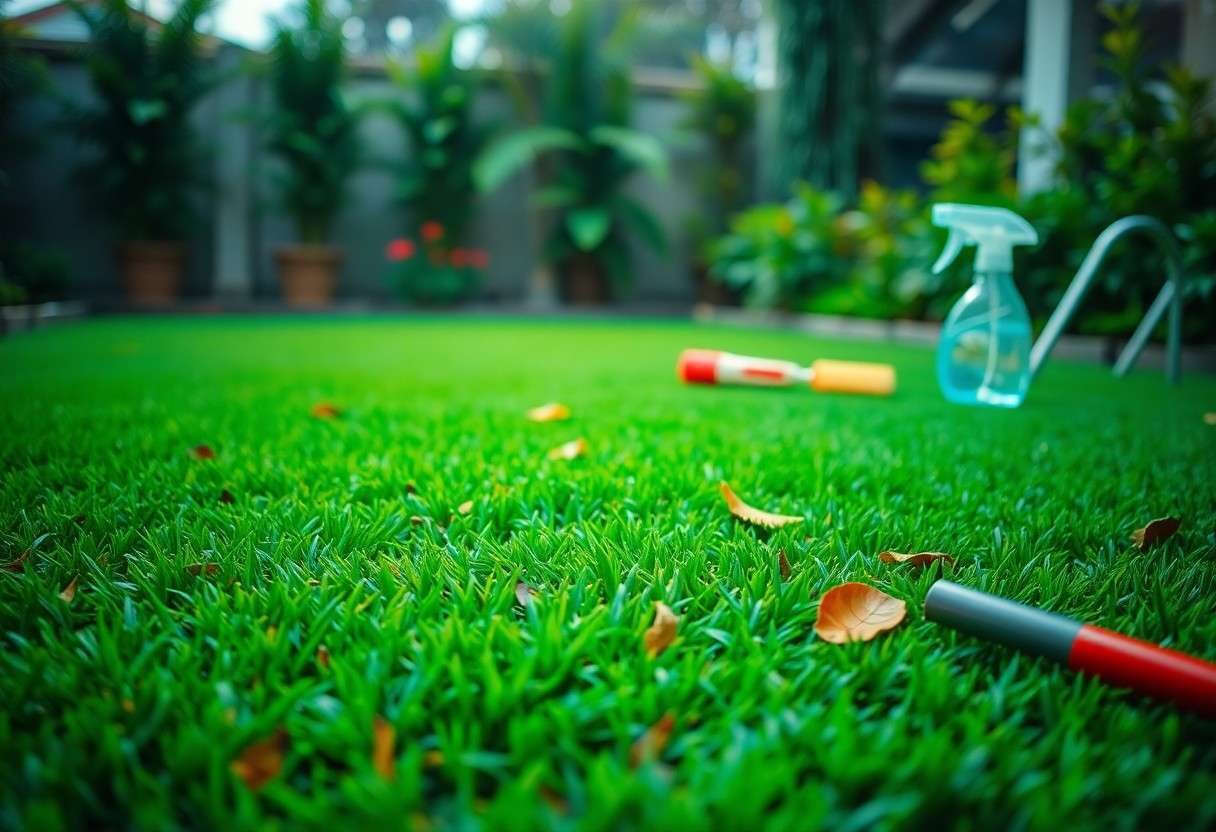It’s easy to overlook the condition of your artificial turf until issues arise. Knowing when to clean and sanitize your turf helps maintain its appearance, safety, and longevity. From unpleasant odors to drainage problems, certain signs indicate your turf needs attention. By recognizing these early, you can protect your investment and ensure a healthy, vibrant lawn for your family, pets, or customers. In this post, you’ll learn the key indicators that signal it’s time to refresh your turf through professional cleaning and sanitizing.
Key Takeaways:
- Visible dirt buildup, unpleasant odors, and flattened grass fibers indicate that turf cleaning and sanitizing are needed to maintain appearance and hygiene.
- High-traffic areas and pet zones often require more frequent maintenance, including turf decompaction and odor removal, to keep the surface safe and comfortable.
- Regular turf sanitizing helps protect children, pets, and families from germs and allergens, extending the lifespan and freshness of artificial grass.

Detecting the Subtle Signs of Turf Neglect
Your artificial turf can start showing subtle signs of wear and neglect long before major issues appear. Areas with heavy foot traffic might feel compacted, while spots under dog runs or playgrounds can begin to lose their plush texture. You might notice bits of debris settling into the fibers or an overall dullness developing. These early indicators often lead to problems like poor drainage or odor retention if left unaddressed, signaling that it’s time to bring in professional turf maintenance services like those offered by Totally Clean Turf to refresh and protect your investment.
Discoloration: When Your Turf Loses Its Luster
Fading or discoloration can make your turf look tired and worn, especially in areas frequently exposed to harsh sunlight or heavy use. UV rays break down the pigments over time, and trapped dirt or organic debris may cause staining that washing alone won’t fix. If you spot uneven coloring or patches losing vibrancy, it’s a sign that turf blooming and cleaning treatments are needed to restore that fresh, green look and maintain the lawn’s curb appeal.
Unpleasant Odors: The Red Flag of Urgent Cleaning Needs
Odors from pet urine, organic matter, or trapped moisture rarely fade without targeted cleaning, turning your turf’s inviting surface into a source of embarrassment. Persistent smells often mean bacteria buildup or ineffective drainage beneath the synthetic grass. Addressing these odors promptly with specialized pet turf odor removal and sanitizing treatments can eliminate the source and prevent further damage or health concerns for kids and pets.
Pet urine contains ammonia and other compounds that quickly seep into the turf backing and infill materials, creating an environment where bacteria thrive, causing those stubborn odors. Even with routine rinsing, these contaminants can linger, especially in shaded or compacted zones. Advanced odor removal techniques used by experts like Totally Clean Turf employ enzymatic cleaners and sanitizers designed to break down organic residues at the molecular level, restoring freshness and ensuring the surface remains safe and hygienic for family and pets alike.
High-Traffic Areas and Their Impact on Turf Longevity
High-traffic zones on your artificial turf often experience fiber flattening, compaction, and accelerated wear that can reduce both appearance and lifespan. Areas like pathways, pet zones, playgrounds, and putting greens face constant pressure and movement, causing turf fibers to lose their upright stance and support base to compact. Recognizing these heavily used spots is crucial for scheduling timely maintenance such as decompaction and turf blooming, which restore softness, improve drainage, and keep your lawn looking vibrant year-round.
Identifying Stress Points: Where Turf Faces Frequent Use
You’ll often find high wear along pet runs, children’s play areas, garden pathways, and entryways, where foot traffic and pet activity are concentrated. These stress points are prone to fiber crushing and debris buildup, increasing odor and drainage issues. Detecting these zones early lets you target cleaning and maintenance effectively, preventing damage from becoming irreversible while maintaining a safe, comfortable environment for kids and pets.
The Decompaction Dilemma: How Pressure Affects Performance
Constant foot traffic and pet activity compress the infill beneath turf fibers, limiting drainage and causing the lawn to feel hard and less natural underfoot. Without decompaction, these compressed areas trap moisture and debris, promoting odor buildup and fiber matting. Regular turf decompaction refreshes the infill structure, restores cushioning, and ensures proper water runoff to keep your synthetic grass both functional and comfortable.
Decompaction targets the tightly packed infill that artificial turf relies on for support and drainage. Studies show that high-traffic areas can experience up to a 40% reduction in infill porosity within months if left untreated, leading to poor drainage and a firm, uncomfortable surface. By mechanically loosening and redistributing the infill, you improve airflow and water passage through the turf base, preventing mold, mildew, and pet odor accumulation. This process also helps turf fibers stand upright longer, preserving the synthetic grass’s lush aesthetic and extending its usable life, especially in high-use residential backyards and commercial playfields serviced by Totally Clean Turf.
The Role of Animal Activity in Turf Health
Animal activity significantly impacts the condition of your artificial turf, especially if pets spend frequent time outdoors. Regular running, digging, or resting can lead to turf compaction, fiber flattening, and accumulation of organic matter. Over time, these effects reduce drainage efficiency and create patches where odors develop. Managing pet activity zones with targeted maintenance helps you preserve a fresh, resilient surface that stands up to playful pets while maintaining its clean appearance.
Pet Residue: Noxious Effects on Artificial Grass
Pet urine and feces introduce bacteria and ammonia compounds into the turf, accelerating fiber degradation and creating unpleasant smells. Without consistent cleaning, these residues cause stubborn stains and encourage mold or algae growth in shaded or damp areas. You’ll notice yellowing spots and a decline in fiber texture if residue buildup is left untreated, which highlights the need for specialized turf cleaning adapted for artificial grass used by pets.
Essential Odor Removal: Techniques to Restore Freshness
Advanced odor removal involves deep cleaning treatments that neutralize pet smells at the source rather than masking them. Applying enzymatic cleaners and sanitizers specifically formulated for artificial grass breaks down organic odors and eliminates bacteria responsible for lingering scents. Combining these with routine debris removal and turf rinsing keeps your landscape smelling fresh and safe for family and pets alike.
Enzymatic cleaners used by professionals like Totally Clean Turf target the molecules causing urine odors by biologically breaking them down, preventing odor recurrence. This method outperforms standard detergents and provides lasting freshness even in high-traffic pet areas. Pairing enzymatic treatments with thorough turf decompaction and sanitizing protocols ensures airflow and surface cleanliness, which inhibit bacterial growth and maintain the turf’s vibrant look. You’ll notice a dramatic reduction in odors when employing these precise techniques regularly.
Weather Effects: How Nature Can Compromise Your Turf
Exposure to sun, rain, wind, and temperature fluctuations can gradually wear down your artificial turf if left unchecked. UV rays may fade colors and weaken fibers, while rain can contribute to debris buildup and promote mold growth if drainage is inadequate. Over time, weather-related wear can flatten fibers and cause unpleasant odors, especially in pet areas. Regular cleaning and maintenance help counteract these natural stressors, preserving the vibrant appearance and functional benefits you expect from your low-maintenance lawn.
Seasonal Changes and Their Toll on Artificial Grass
With Southern California’s varied seasons, your turf faces unique challenges throughout the year. Winter rain may saturate and compact the turf backing, while the intense summer heat causes the fibers to become brittle or sticky. Spring pollen and fall leaves accumulate quickly, increasing the need for thorough debris removal. Seasonal maintenance, including turf blooming and sanitizing, ensures your artificial grass stays plush, safe, and visually appealing no matter the weather swings.
Flooding and Drainage Issues: Signs That Can’t Be Ignored
Pooling water and soggy patches under or around artificial turf indicate drainage problems that can degrade the turf’s foundation. Consistent standing water invites mold and mildew, damaging both synthetic fibers and the turf’s infill. You may also notice a musty smell or bacterial buildup, especially in pet zones. Addressing drainage issues early prevents costly repairs and maintains your turf’s longevity and hygiene, keeping your lawn healthy for family and pets alike.
Flooding problems often stem from compacted soil, clogged drainage pipes, or improper turf installation, all of which affect water’s ability to flow freely. Turf decompaction techniques relieve soil compression, improving permeability and preventing water from stagnating. In some cases, integrating custom concrete or paver solutions around your turf helps redirect runoff efficiently. Professional evaluation by turf maintenance experts ensures drainage systems meet site-specific needs and safeguards your investment against weather-related damage.

Routine Maintenance: Best Practices for Prolonging Turf Life
Regular brushing helps keep turf fibers upright and prevents matting, especially in high-traffic zones like dog runs or play areas. Using a leaf blower or gentle rake removes debris that can degrade drainage and promote bacteria growth. Rinsing pet zones frequently with water, combined with targeted odor removal treatments, preserves freshness and hygiene. Scheduling annual turf decompaction invigorates drainage and softness, while turf blooming restores natural, plush aesthetics. These simple, consistent steps extend your turf’s lifespan and maintain its vibrant look year-round.
When to Call in Professionals: Regular vs. Emergency Care
Ongoing turf care like debris removal and light rinsing can be handled independently, but professional intervention is best for deep cleaning, odor neutralization, and sanitizing, particularly after heavy pet use or playground activity. Emergency service is warranted when you notice persistent foul odors, unexpected drainage problems, or visible turf damage from weather or excessive wear. Licensed experts bring specialized equipment and eco-friendly treatments, ensuring comprehensive restoration without compromising turf integrity or your family’s safety.
DIY Cleaning Techniques: What Homeowners Can Safely Do
You can manage routine turf upkeep easily with basic tools: a stiff bristle broom for brushing fibers upright, a leaf blower or plastic rake for debris removal, and a garden hose to flush away dirt and pet waste. Baking soda sprinkled in pet areas before rinsing helps absorb odors. Avoid harsh chemicals or pressure washers that risk turf damage. These manageable steps keep your turf clean, fresh, and inviting between professional visits.
Beyond brushing and watering, a focused approach to turf cleaning makes a difference you’ll see and smell. Applying enzymatic cleaners specifically formulated for artificial grass targets organic residues without harming fibers. For pet areas, spreading a thin layer of baking soda before rinsing can significantly reduce odor buildup. Make sure to remove leaves and debris promptly after storms to prevent mold or mildew growth. These DIY techniques, paired with occasional professional maintenance, keep your turf healthy and vibrant, enhancing your investment’s longevity and appearance.
Final Words
With these considerations in mind, you can easily identify when your turf needs cleaning and sanitizing to maintain its appearance and safety. Whether you notice persistent odors, reduced softness, or visible debris buildup, addressing these signs promptly will help extend the life of your artificial grass and keep it healthy for your family and pets. Taking proactive care ensures your turf stays fresh, vibrant, and inviting for every use.
FAQ
Q: How can I tell if my artificial turf needs cleaning and sanitizing?
A: If you notice unpleasant odors, especially pet-related smells, visible dirt or debris buildup, or discoloration in your turf fibers, it’s a good indication that your artificial grass requires cleaning and sanitizing. High-traffic areas that feel compacted or less soft than usual are also signs that maintenance like turf decompaction and turf blooming is needed to restore the turf’s appearance and functionality.
Q: What impact does regular turf sanitizing have on family and pets?
A: Regular turf sanitizing helps eliminate harmful bacteria, allergens, and organic contaminants that can accumulate on synthetic grass surfaces. This process creates a safer play and activity area for children and pets by reducing exposure to germs and odors, ensuring a fresher and healthier environment in your yard or commercial space.
Q: How often should turf decompaction and turf blooming be performed to maintain the turf’s quality?
A: The frequency of turf decompaction and turf blooming depends on usage levels and environmental factors. Areas with heavy foot traffic or active pets generally benefit from maintenance every 6 to 12 months, while less-used sections may only require attention once a year. Regular assessments help maintain optimal drainage, softness, and the natural upright appearance of the turf fibers.



